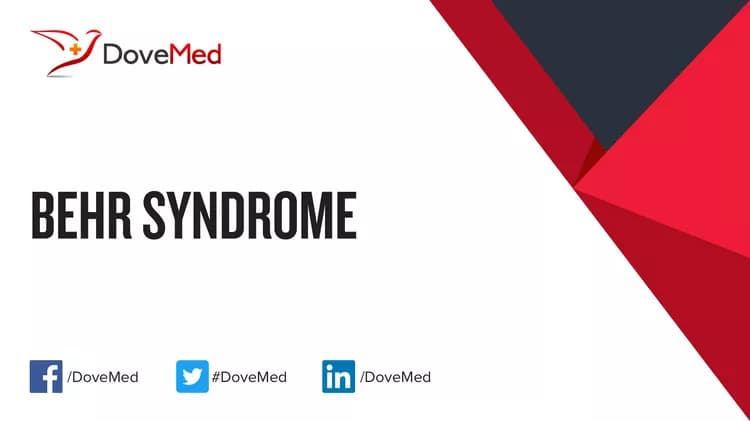What are the other Names for this Condition? (Also known as/Synonyms)
- Behr's Complicated Optic Atrophy of Infancy
- Complicated Form of Optic atrophy, Infantile Hereditary, Behr type
- Optic Atrophy in Early Childhood, associated with Ataxia, Spasticity, Mental Retardation, and Posterior Column Sensory Loss
What is Behr Syndrome? (Definition/Background Information)
- Behr Syndrome is a disorder characterized by early-onset optic atrophy along with neurological features, including ataxia, spasticity, and intellectual disability
- Other signs and symptoms may be present and vary from person to person
- This condition is caused by mutations in the OPA1 gene. It is inherited in an autosomal recessive manner
- Treatment depends on the specific signs and symptoms seen in the patient
(Source: Behr Syndrome; Genetic and Rare Diseases Information Center (GARD) of National Center for Advancing Translational Sciences (NCATS), USA.)
Who gets Behr Syndrome? (Age and Sex Distribution)
- Behr Syndrome is a rare congenital disorder. The presentation of symptoms may occur at or following the birth of the child
- Both males and females may be affected
- Worldwide, individuals of all racial and ethnic groups may be affected
What are the Risk Factors for Behr Syndrome? (Predisposing Factors)
- A positive family history may be an important risk factor, since Behr Syndrome is an inherited condition
- Currently, no risk factors have been clearly identified for the syndrome
It is important to note that having a risk factor does not mean that one will get the condition. A risk factor increases one’s chances of getting a condition compared to an individual without the risk factors. Some risk factors are more important than others.
Also, not having a risk factor does not mean that an individual will not get the condition. It is always important to discuss the effect of risk factors with your healthcare provider.
What are the Causes of Behr Syndrome? (Etiology)
- Many cases of Behr syndrome have been found to result from homozygous or compound heterozygous mutations in the OPA1 gene
- This gene provides instructions for making a protein that helps determine the shape and structure of mitochondria, the energy-producing centers within cells
- The OPA1 protein is made in many types of cells and tissues, including the brain, the light-sensitive tissue at the back of the eye (the retina), muscles used for movement (skeletal muscles), the liver, and the heart
- It is unclear why people with mutations in the OPA1 gene develop the symptoms of Behr syndrome
A few additional cases of Behr syndrome have been attributed to mutations in the OPA3, C12ORF65 and C19ORF12 genes.
(Source: Behr Syndrome; Genetic and Rare Diseases Information Center (GARD) of National Center for Advancing Translational Sciences (NCATS), USA.)
What are the Signs and Symptoms of Behr Syndrome?
The signs and symptoms of Behr Syndrome may include:
- Achilles tendon contracture
- Adductor longus contractures
- Babinski sign
- Cerebellar atrophy
- Dysmetria
- Gait disturbance
- Hamstring contractures
- Hyperreflexia
- Motor delay
- Progressive
- Progressive spasticity
- Progressive visual loss
- Tremor
Based on the frequency of symptoms observed, the following information may be noted:
Very frequently present symptoms in 80-99% of the cases:
- Abnormality of color vision
- Ataxia
- Intellectual disability
- Nystagmus
- Optic atrophy
- Spasticity
- Strabismus
Frequently present symptoms in 30-79% of the cases: Visual impairment
(Source: Behr Syndrome; Genetic and Rare Diseases Information Center (GARD) of National Center for Advancing Translational Sciences (NCATS), USA.)
How is Behr Syndrome Diagnosed?
Behr Syndrome is diagnosed on the basis of the following information:
- Complete physical examination
- Thorough medical history evaluation
- Assessment of signs and symptoms
- Laboratory tests
- Imaging studies
- Biopsy studies, if necessary
Many clinical conditions may have similar signs and symptoms. Your healthcare provider may perform additional tests to rule out other clinical conditions to arrive at a definitive diagnosis.
What are the possible Complications of Behr Syndrome?
The complications of Behr Syndrome may include:
- Loss of vision
- Intellectual impairment
Complications may occur with or without treatment, and in some cases, due to treatment also.
How is Behr Syndrome Treated?
- The treatment of Behr Syndrome is symptomatic
- For instance, people who develop muscle contractures may have to undergo surgery.
(Source: Behr Syndrome; Genetic and Rare Diseases Information Center (GARD) of National Center for Advancing Translational Sciences (NCATS), USA.)
How can Behr Syndrome be Prevented?
- Currently, Behr Syndrome may not be preventable, since it is a genetic disorder
- Genetic testing of the expecting parents (and related family members) and prenatal diagnosis (molecular testing of the fetus during pregnancy) may help in understanding the risks better during pregnancy
- If there is a family history of the condition, then genetic counseling will help assess risks, before planning for a child
- Active research is currently being performed to explore the possibilities for treatment and prevention of inherited and acquired genetic disorders
- Regular medical screening at periodic intervals with tests and physical examinations are recommended
What is the Prognosis of Behr Syndrome? (Outcomes/Resolutions)
The prognosis of Behr Syndrome is dependent upon the severity of the signs and symptoms and associated complications, if any. However, typically, the prognosis is poor.
Additional and Relevant Useful Information for Behr Syndrome:
The following DoveMed website link is a useful resource for additional information:
Related Articles
Test Your Knowledge
Asked by users
Related Centers
Related Specialties
Related Physicians
Related Procedures
Related Resources
Join DoveHubs
and connect with fellow professionals


0 Comments
Please log in to post a comment.